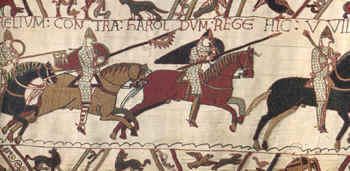The Bayeux Tapestry is really an embroidery but the word tapestry has stuck. The Bayeux Tapestry is now on permanent public display in the city of Bayeux in Normandy, France. It tells the story of the Battle of Hastings; why William felt he had to invade, the preparations made for the crossing and the battle itself. Tapestries were not rare in the time of William but the size of this particular tapestry is an indication that it was important. The story it tells was to have a huge impact on Medieval England.
|
|
It is made out of linen (eight bands sewn together) and is 270 feet long and about 20 inches wide. It was once even longer but part of the tapestry at the end – after the Battle of Hastings – has been cut off. The writing on the tapestry is in Latin. The main stitches used are stem stitching and laid-and-couched stitching.
Eight colours can be made out from the tapestry; the five main colours are blue-green, terracotta, light-green, buff and grey-blue. There are also places where very dark blue, yellow and a dark green have been used. The colour of skin has been left as the colour of the linen.
The tapestry tells from the Norman point of view the circumstances that lead up to the Battle of Hastings. There is no English equivalent so it is very difficult to confirm or dispute some of the details on the tapestry.
It is probable that the man who ordered the tapestry to be done was Bishop Odo of Bayeux. He was William’s half-brother and his cathedral in Bayeux was consecrated in 1077. It is likely that the tapestry was done to celebrate both William’s victory at Hastings and the completion of Odo’s cathedral.
No-one is completely sure where the tapestry was made but one theory put forward was that it was done by women in Canterbury, Kent, where there was a famous school of tapestry who used a style of work very similar to that found on the tapestry itself.
After William’s victory at Hastings, Odo was made Earl of Kent so it is probable that he would have had full knowledge about this particular school. Another clue is that some of the names spelt in Latin on the tapestry are not spelt in the way a French person would have written them but they are spelt in the English style of the time.
Though the tapestry was almost certainly done by women, the design and plan of it was probably done by a man as the detail of the soldiers who fought at the Battle of Hastings is such that only a soldier or ex-soldier would have known of such detail.
The tapestry contains about 50 different scenes and one researcher has counted that there are 632 human figures in it, 202 horse, 55 dogs, 505 other creatures (some clearly mythical beasts), 37 buildings, 41 ships, 49 trees and nearly 2000 Latin letters.
Though some historians have stated that the tapestry is nothing more than Norman propaganda – somehow excusing William’s right to invade and conquer England – some parts of it are less than pro-Norman as one section shows a mother and child being forced out of the burning home (set alight by Norman soldiers) as William’s army advanced across Kent. The scale of the damage done to the area surrounding Hastings can be seen in the figures contained in the Domesday Book.
Though the tapestry is now a major tourist attraction, it does have a strange history. There was a vague mention made by the Bishop of Dol of a tapestry that was in the possession of Adela, William’s daughter. This was in 1100.
No proper mention is made of it until 1476 when someone writing an inventory of what was found in Bayeux Cathedral noted that a “very long and very narrow strip of linen, embroidered with figures and inscriptions representing the Conquest of England, which is hung round the nave of the church on the Feast of relics and throughout the Octave.”
During the troublesome days of the French Revolution, it was going to be used as a wrap-around for a wagon to save its contents from the weather, but it was saved at the last minute by a member of Bayeux’s city council – Lambert Leonard-Leforestier.
During World War Two, it was kept in an air-raid shelter. Bayeaux, as a city, remained undamaged in the war even though the Allied beach landings took place just miles from the city. In 1949, the tapestry was given an official exhibition centre.

